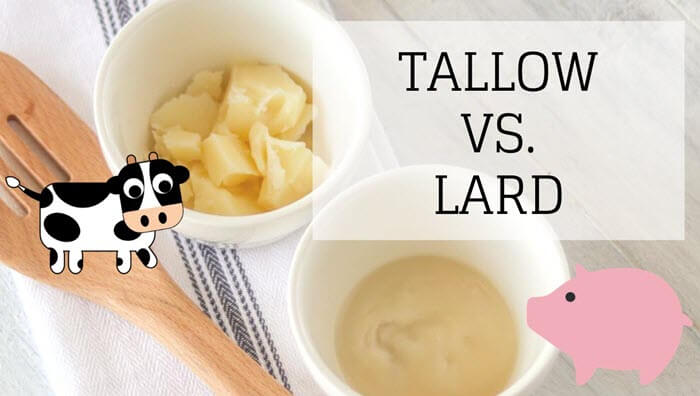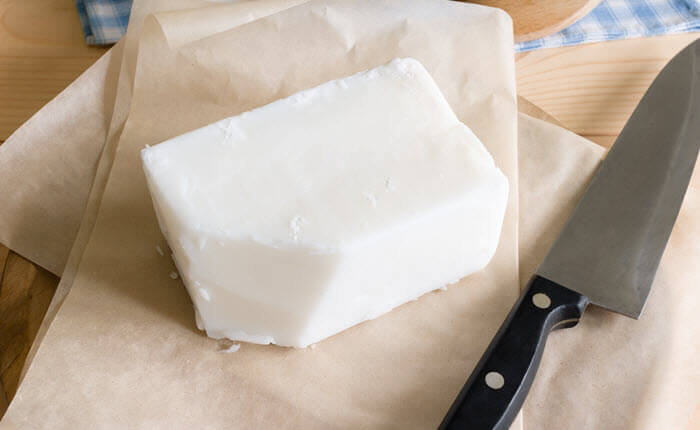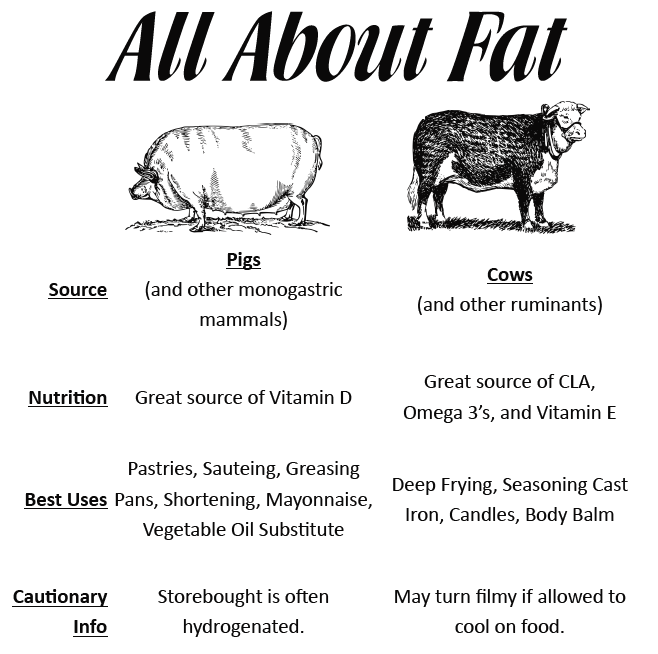When it comes to cooking, the versatility and variety make all the difference. Fat and oil choice is not left out, apart from the conventional oils used in cooking that add flavor to certain meals, fats like tallow and lard are great ingredients in some meals.
Many people struggle to choose between lard vs tallow as they can’t tell the difference or their use.
So in this article, we set out to “melt” this confusion by giving answers to questions like what are they? Can they be substituted for each other? What are their uses?
Let’s get to it!
Table Of Contents
What is Tallow?
Simply put, tallow is rendered beef or mutton fat (called suet). The fat used in tallow production is found in the organs like kidneys and loins.
Tallow is not just a good cooking ingredient, it can be used for making soap, candles, skin balms, and traditional lubricants for metal, leather, and wood industries. Tallow has quite a versatile application.
So, where does tallow come from?
Tallow is a hard fat that usually is obtained from cows, sheep, and other grazing animals, even deers. This makes the foremost distinction between Tallow and Lard.
What does “rendered” mean?
Rendering means warming up the raw fat in an animal to separate it from its connective tissue to produce cooking oil.
The process of rendering is quite simple, gently heating the fat to separate it from any muscle it is attached to, and the final result is pure fat that turns solid after it is cooled at room temperature.
Now that we know what Tallow is, let’s dive right into the introduction to Lard.
What is Animal Lard?
Lard is rendered pork fat. It is derived from either wet rendering (adding water to the fat, thus steaming or boiling at high temperature thus causing the lard to float in the mixture due to insolubility), or dry rendering (rendering without water).
So, where does lard come from?
Pigs usually have a high fat composition in their bodies, this thick fat layer provides a huge quantity of fat. Lard is gotten from the belly of the pig and some other organs.
Now that we know clearly and distinctly what Tallow and Lard are, let us discuss their differences.
If you’re interested in lard, click here to find its 12 substitutes.
Difference Between Lard and Tallow
As seen already, Lard is pork fat while Tallow is beef or mutton fat. But if you are a lover of fat, and like glossy foods, you might want to take note of the specific differences between both fats.
Source
Pigs are huge sources of fat, and this fat can be found largely in two areas: the fat under the skin, known as back fat, and the fat stored around the kidneys. The amount of fat stored in those two areas depends solely on the pig breed and how the pig was raised.
- Back fat usually produces less saturated fat, lard, and might be rich in Vitamin D since it is produced in the skin.
- The fat stored around the kidneys in pigs’ bodies is more saturated and could be tougher or stiffer at certain temperatures.
On the other hand, beef fat comes principally from the kidneys. This doesn’t mean there is no fat under the cow’s skin, it just means the fat in the skin is not as thick as that of the pig, hence harvesting it for oil would be difficult.
Texture
At room temperature, lard is softer, while tallow is a bit stiffer.
When tallow cools, its solid-state has a similar texture to cold butter. It also has a hard and brittle texture, that’s not very malleable. So, tallow is not a great choice for pastries but perfect for frying, roasting, cooking, and others. When used in a meal, it leaves a “filmy” aftertaste in your mouth if you allow your meal to cool down.
On the other hand, Lard stays in its liquid state after rendering and pretty much stays soft at room temperature. It is a great ingredient for frying, baking, and others.
Flavor and Taste
Lard has a very neutral taste if it’s rendered properly, and it’s a great choice if you are looking to introduce animal fat into your foods. Lard is a great ingredient in your pastries and other baked foods. This is because its neutral taste and flavor blend in just right!
Tallow, on the other hand, is beefy and more flavourful. It has a “beefy” flavor that creates a delightful sensation. Tallow is great for making French fries, even McDonald’s discovered the beauty of its “beefiness” back in the 1940s. Sadly, it had to be replaced with other oil types.
Nutrition
When pasture-raised pigs bask in the sun, their hormones help them produce Vitamin D which is stored in their skins. And since they have a lot of fat beneath their skin, the fat stores up Vitamin D as well. So Lard gotten from pasture trained pigs is a great source of Vitamin D [1] second only to cod liver oil.
As for Tallow, it is also packed with necessary nutrients like Vitamin E, Omega-3 fatty acids, and Conjugated Linoleic Acid (CLA). Just like in Lard, these nutrients are best gotten from grass-fed cows, their natural fat is packed with such nutrients.
Animal fats are great sources of nutrients, so if you would like to pump your nutrient intake, you might want to consider adding lard or tallow your recipe. With their addition you get nutrients and you also get the flavor, a “win-win” for your meal!
The final difference we would discuss between lard and tallow would fall under other uses.
Other uses of Lard and Tallow
A beautiful aspect of animal fat is that it is not just specific to kitchen use only. They can be added to other things.
Tallow is a great ingredient in making soothing balms, it’s a great skincare product used in soaps and traditionally used in candle production.
While lard is mostly used in the kitchen but it can be used in grease containers, used in protecting leather and wood surfaces.
When it comes to other uses of these fat sources, they can both be used for a variety of things, you can choose which works best for you.
Are Tallow and Lard the Same Thing?
From the explanations we have seen so far we can safely say the answer is, No. Let’s get a summary of why they are not:
- Tallow is rendered beef, mutton, or even deer fat while Lard is rendered pig fat.
- Tallow is a bit thick and solid at room temperature while Lard is usually liquid after rendering and if it turns solid, it’s way softer than tallow.
- Lard is great for your baking recipes as it’s more malleable while Tallow is more brittle hence great for frying.
- Lard is a generous source of Vitamin D while Tallow is a good source of Vitamin A, Omega-3 fatty acid, and CLA.
- Lard is best used in sautéing, baking, greasing, vegetable oil substitute while Tallow works best in deep frying, seasoning, candle, and balm creation.
FAQs About Lard and Tallow
What is sheep or beef fat called?
Both sheep fat and beef fat can be called tallow. It’s a rendered form of fat, primarily made up of triglycerides.
What is pig fat called?
Pig fat is called lard, a semi-solid white fat product.
Suet vs. lard vs. tallow vs. ghee: what’s the difference?
- Suet is a solid fat obtained from the fatty part of the mutton or cows that surrounds the kidneys.
- Lard is a semi-solid white fat obtained from pigs.
- Tallow is the rendered down fat from Suet.
- Ghee is clarified butter that is simmered and strained of milk solids and water.
Further reading: Vegan & Non-vegan Substitutes for Ghee in Indian Cooking
Duck fat vs. lard: what’s the difference?
Duck fat has higher water content which can help you stay hydrated and transport nutrients and oxygen throughout the body.
Read also: 14 Healthy Duck Fat Substitutes
Does tallow need to be refrigerated? How long is it good for?
You don’t have to refrigerate tallow because it can last at least one year at room temperature.
What is the difference between lard and shortening?
The main difference between lard and shortening is that lard is animal fat, while shortening is made from vegetable oil.
Final Words
When it comes to what ingredients are part of your meal, it all “melts” down to your choice and the taste you aim to achieve.
So, do not be afraid to try new things, and while at it also boost the nutrient content of your meal by incorporating some form of delicious Lard or Tallow.





Really liked how you put this, the distinctions, uses, and nutritional values – so much has been forgotten in the last 50 years.
Happy to help 🙂
Great explanation, thank you for this.
This native dish now commonly uses Crisco as a substitute for animal fat.
I’ve been researching health benefits of animal fats vs vegetable oils and there’s a good argument that animal fats are healthier.